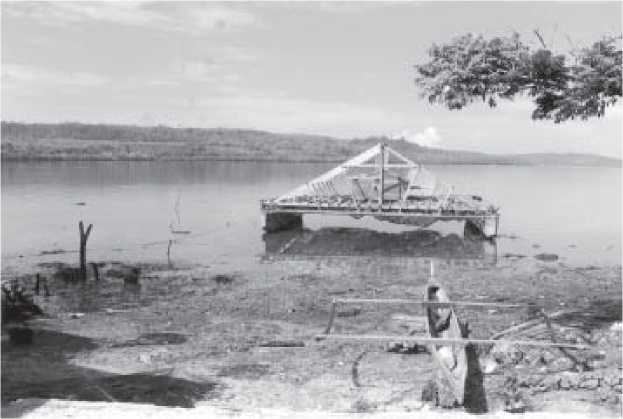Chapter 5
The Fisheries and Fish Markets of Central Maluku
5.1 Profile of Fishers in Villages of Central Maluku
The profile of 508 fishers interviewed in central Maluku in 1997 shows them to be predominantly
45-52 years old (average 47 years, see Table 5.1). Most have only elementary education and only
11% have finished high school or proceeded to higher education. Most own land and live in semi-
permanent or permanent housing made either partly or entirely of cement. About three-quarters
have their own fishing boats, but very few own motors. This is very similar to the demography of
the Indonesian fishery in general. Almost a third of the fishers we surveyed do not own their
own gears but fish for someone else. Of those who have gears, a third have only hand lines while
the rest use nets (gill net, seine, etc.) and traps. A very small proportion own or have shares in
commercial gears such as lift nets (bagans; see Figure 5.1) or FADs (rumpons).
From the data, we see that the central Maluku fishery can be divided into two basic groups:
artisanal and commercial. A harvester who fishes from the shore or from a small perahu without
a motor and uses a hand line, spear, trap or simple net, is considered artisanal. Operators of
large pole and line vessels, seiners using deep-water fish aggregating devices (FADs) and floating
lift nets, together with their crew, are clearly in the commercial sector. In the middle are the gill
netters and seiners using small, motorized craft: the small-scale commercial fishers. The majority
of central Maluku fishers falls into the artisanal category and are, in fact, fisher-farmers.
According to the Fisheries Agency (Dinas Perikanan) statistics, in 1997, fisher-farmers earned an
average of Rp1,124,000 per year (± USD450, early 1997 exchange rate). Our results suggest that
their livelihoods are currently in danger. Overall, fishers interviewed considered fish catches and
environmental health to be declining. We found that the oldest fishers, especially those over 60
years of age, report a dramatic decline in marine environmental health over the past 15 years (i.e.,
-41%) and a severe drop in fish catches (-33%). The younger fishers also perceive serious declines:
27-31% in environmental health and 25-27% in catches compared to 15 years ago.

Figure 5.1. (Photo) Lift net in Tuhaha Bay, with a local
outrigger boat (perahu) in the foreground.
The Fisheries and Fish Markets of Central Maluku 47
More intriguing information
1. The name is absent2. Modeling industrial location decisions in U.S. counties
3. The Role of area-yield crop insurance program face to the Mid-term Review of Common Agricultural Policy
4. Road pricing and (re)location decisions households
5. Studies on association of arbuscular mycorrhizal fungi with gluconacetobacter diazotrophicus and its effect on improvement of sorghum bicolor (L.)
6. The name is absent
7. THE DIGITAL DIVIDE: COMPUTER USE, BASIC SKILLS AND EMPLOYMENT
8. Nurses' retention and hospital characteristics in New South Wales, CHERE Discussion Paper No 52
9. The name is absent
10. On the Real Exchange Rate Effects of Higher Electricity Prices in South Africa